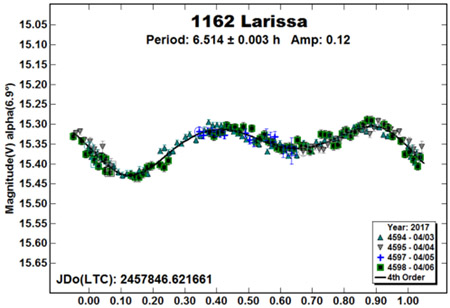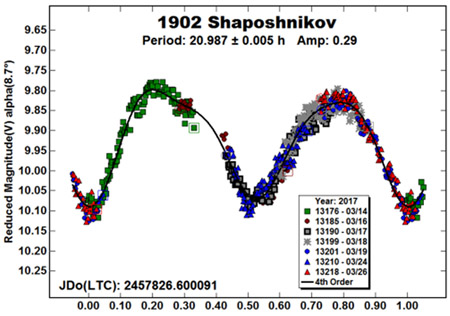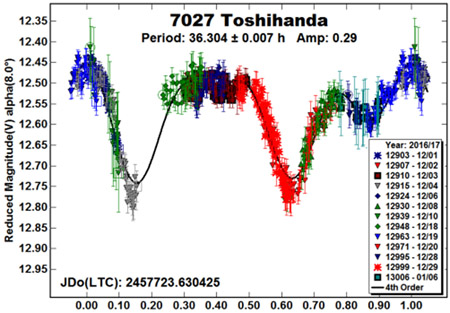Abstract
Lightcurves for four Hilda asteroids were obtained at the Center for Solar System Studies (CS3) from 2016 December thru 2017 April.
CCD photometric observations of four Hilda asteroids were made at the Center for Solar System Studies (CS3) from 2016 December thru 2017 April. This is another in a planned series of papers on this group of asteroids, which is located between the outer main-belt and Jupiter Trojans in a 3:2 orbital resonance with Jupiter. The goal is to determine the spin rate statistics of the group and find pole and shape models when possible. We also we look to examine the degree of influence that the YORP effect (Rubincam, 2000) has on distant objects and to compare the spin rate distribution against the Jupiter Trojans, which can provide evidence that the Hildas are more “comet-like” than main-belt asteroids.
Table I lists the telescopes and CCD cameras that are combined to make observations. Up to nine telescopes can be used for the campaign, although seven is more common. All the cameras use CCD chips from the KAF blue-enhanced family and so have essentially the same response. The pixel scales ranged from 1.24-1.60 arcsec/pixel. All lightcurve observations were unfiltered since a clear filter can result in a 0.1-0.3 magnitude loss. The exposures varied depending on the asteroid’s brightness and sky motion.
Table I.
List of available telescopes and CCD cameras at CS3. The exact combination for each telescope/camera pair can vary due to maintenance or specific needs.
| Telescopes | Cameras |
|---|---|
| 0.30–m f/6.3 Schmidt–Cass | FLI Microline 1001E |
| 0.35–m f/9.1 Schmidt–Cass | FLI Proline 1001E |
| 0.35–m f/11 Schmidt–Cass | SBIG STL–1001E |
| 0.40–m f/10 Schmidt–Cass | |
| 0.50–m f/8.1 Ritchey–Chrétien |
Measurements were made using MPO Canopus. The Comp Star Selector utility in MPO Canopus found up to five comparison stars of near solar-color for differential photometry. Catalog magnitudes were usually taken from the CMC-15 (http://svo2.cab.inta-csic.es/vocats/cmc15/) or APASS (Henden et al., 2009) catalogs. The MPOSC3 catalog was used as a last resort. The last catalog is based on the 2MASS catalog (http://www.ipac.caltech.edu/2mass) with magnitudes converted from J-K to BVRI (Warner, 2007). The nightly zero points for the catalogs are generally consistent to about ±0.05 mag or better, but on occasion reach 0.1 mag and more. There is a systematic offset among the catalogs so, whenever possible, the same catalog is used throughout the observations for a given asteroid. Period analysis is also done with MPO Canopus, which implements the FALC algorithm developed by Harris (Harris et al., 1989).
In the plots below, the “Reduced Magnitude” is Johnson V as indicated in the Y-axis title. These are values that have been converted from sky magnitudes to unity distance by applying −5*log (rΔ) to the measured sky magnitudes with r and Δ being, respectively, the Sun-asteroid and Earth-asteroid distances in AU. The magnitudes were normalized to the given phase angle, e.g., alpha(6.5°), using G = 0.15, unless otherwise stated. The X-axis is the rotational phase ranging from −0.05 to 1.05.
If the plot includes an amplitude, e.g., “Amp: 0.65”, this is the amplitude of the Fourier model curve and not necessarily the adopted amplitude for the lightcurve.
For the sake of brevity, only some of the previously reported results may be referenced in the discussions on specific asteroids. For a more complete listing, the reader is directed to the asteroid lightcurve database (LCDB; Warner et al., 2009). The on-line version at http://www.minorplanet.info/lightcurvedatabase.html allows direct queries that can be filtered a number of ways and the results saved to a text file. A set of text files of the main LCDB tables, including the references with bibcodes, is also available for download. Readers are strongly encouraged to obtain, when possible, the original references listed in the LCDB for their work.
1162 Larissa.
Waszczak et al. (2015) found a period of 6.520 h for Larissa, which has an estimated diameter of 44 km. Pligge et al. (2011) found a period of 6.514 h, which corresponds to the period we found based on our 2017 observations.

1180 Rita.
Several significantly different periods have been reported in previous years for Rita, which has an estimated diameter of 83 km (LCDB; Warner et al., 2009). Gonano et al. (1991) reported a period of 14.72 h from observations in 1989. Dahlgren et al. (1998) found a similar period of 14.902 h. On the other hand, Slyusarev et al. (2012) found a period of 20.496 and Polishook (2012) reported 9.605 h. The results from PDS based on observations from 2016 Dec 11 thru 2017 Jan 26 only add to the uncertainty.
The period spectrum shows one strong solution at 13.090 ± 0.002 h. There is no simple integral ratio that ties this period to any of the other results. Attempts to fit the most recent data to the other periods by adjusting nightly zero points failed to find a convincing solution.

1902 Shaposhnikov.
Gonano et al. (1991) reported a period of 21.34 h for this Hilda, which has an estimated diameter of 97 km. Dahlgren et al. (1998) closely agreed with their result of 21.2 h. Hanus et al. (2016) found a shape model using lightcurve inversion. They also reported two possible pole solutions; the preferred solution had ecliptic coordinates of (λ = 326°, β = 37°) while the second had coordinates of (λ = 144°, β = 79°). The sidereal rotation period was 20.9959 h.

The analysis of the PDS data found a synodic period of 20.987 h, which is in keeping with the earlier results. The additional data will be sent to Hanus to see if they might help resolve the pole ambiguity.
7027 Toshihanda.
The only previously reported period was from Waszczak et al. (2015), who found a period of 18.148 h. The PDS data led to a period double that, 36.304 h and the strong probability that the asteroid is a binary.

The period makes it a good candidate for being a partially asynchronous binary with a faster spinning primary (period 4-5 h). The lack of “shoulders” on the descending and ascending branches would seem to rule out that the object is a fully synchronous binary (Alan Harris, private communications). On these assumptions, and using the attenuations of about 0.25 mag, this allows finding the approximate effective diameter ratio of the satellite to the primary, i.e.,
where Δm is the magnitude drop of 0.25 mag. The value is a lower limit because the minimums are not flat, indicating a total eclipse.
The unusual tertiary minimum at about 0.9 rotation phase would correspond to the satellite being near elongation. Given the low phase angle of the observations, it’s very unlikely these are shadow eclipses. The physical cause of the additional minimum is unknown. It’s possible that observations at future apparitions may help solve the mystery.
Table II.
Observing circumstances. The phase angle (α) is given at the start and end of each date range, unless it reached a minimum, which is then the second of three values. If a single value is given, the phase angle did not change significantly and the average value is given. LPAB and BPAB are each the average phase angle bisector longitude and latitude (see Harris et al., 1984), unless two values are given (first/last date in range).
| Number | Name | 2016/7 mm/dd | Pts | Phase | LPAB | BPAB | Period | P.E. | Amp | A.E. |
|---|---|---|---|---|---|---|---|---|---|---|
| 1162 | Larissa | 04/03–04/06 | 175 | 6.8, 7.6 | 170 | 2 | 6.514 | 0.003 | 0.12 | 0.01 |
| 1180 | Rita | 12/12–01/26 | 304 | 11.1, 3.2 | 139 | 6 | 13.090 | 0.002 | 0.06 | 0.01 |
| 1902 | Shaposhnikov | 03/14–03/04 | 608 | 8.7, 10.0 | 133 | 13 | 20.987 | 0.005 | 0.29 | 0.02 |
| 7027 | Toshihanda | 12/01–12/29 | 568 | 8.0, 14.6 | 47 | −6 | 36.304 | 0.007 | 0.30 | 0.02 |
Acknowledgements
Thanks to Alan Harris for his additional analysis of 7027 Toshihanda. Funding for observations, analysis, and publication for Warner and Stephens was provided by NASA grant NNX13AP56G. Work on the asteroid lightcurve database (LCDB) by Warner was also funded in part by National Science Foundation grant AST-1507535. The authors gratefully acknowledge Shoemaker NEO Grants from the Planetary Society (2007, 2013, 2015). These were used to purchase some of the telescopes and CCD cameras used in this research. This research was made possible through the use of the AAVSO Photometric All-Sky Survey (APASS), funded by the Robert Martin Ayers Sciences Fund. This research was made possible in part based on data from CMC15 Data Access Service at CAB (INTA-CSIC) (http://svo2.cab.inta-csic.es/vocats/cmc15/). This publication makes use of data products from the Two Micron All Sky Survey, which is a joint project of the University of Massachusetts and the Infrared Processing and Analysis Center/California Institute of Technology, funded by the National Aeronautics and Space Administration and the National Science Foundation. (http://www.ipac.caltech.edu/2mass/)
Contributor Information
Brian D. Warner, Center for Solar System Studies – Palmer Divide Station, 446 Sycamore Ave., Eaton, CO 80615 USA
Robert D. Stephens, Center for Solar System Studies, Landers, CA
References
- Dahlgren M, Lahulla JF, Lagerkvist C-I, Lagerros J, Mottola S, Erikson A, Bonano-Beurer M, Di Martino M (1998). “A Study of Hilda Asteroids. V. Lightcurves of 47 Hilda Asteroids.” Icarus 133, 247–285. [Google Scholar]
- Gonano M, Mottola S, Neukum G, di Martino M (1991). “Physical study of outer belt asteroids.” Adv. Space Res. 11, 197–200. [Google Scholar]
- Hanus J, Durech J, Oszkiewicz DA, Behrend R, Carry B, Delbo M, Adam O, Afonina V, Anquetin R, Antonini P, and 159 coauthors. (2016). “New and updated convex shape models of asteroids based on optical data from a large collaboration network.” Astron. Astrophys 586, A108. [Google Scholar]
- Harris AW, Young JW, Scaltriti F, Zappala V (1984). “Lightcurves and phase relations of the asteroids 82 Alkmene and 444 Gyptis.” Icarus 57, 251–258. [Google Scholar]
- Harris AW, Young JW, Bowell E, Martin LJ, Millis RL, Poutanen M, Scaltriti F, Zappala V, Schober HJ, Debehogne H, Zeigler KW (1989). “Photoelectric Observations of Asteroids 3, 24, 60, 261, and 863.” Icarus 77, 171–186. [Google Scholar]
- Henden AA, Terrell D, Levine SE, Templeton M, Smith TC, Welch DL (2009). http://www.aavso.org/apass
- Pligge Z, Monnier A, Pharo J, Stolze K, Yim A, Ditteon R (2011). “Asteroid Lightcurve Analysis at the Oakley Southern Sky Observatory: 2010 May.” Minor Planet Bul. 38, 5–7. [Google Scholar]
- Polishook D (2012). “Lightcurves for Shape Modeling: 852 Wladilena, 1089 Tama, and 1180 Rita.” Minor Planet Bull. 39, 242–244. [Google Scholar]
- Rubincam DP (2000). “Relative Spin-up and Spin-down of Small Asteroids.” Icarus 148, 2–11. [Google Scholar]
- Slyusarev IG; Shevchenko VG; Belskaya IN; Krugly Yu.N.; Chiorny VG (2012). “CCD Photometry of Hilda Asteroids.” ACM 2012, #6398. [Google Scholar]
- Warner BD (2007). “Initial Results of a Dedicated H-G Program.” Minor Planet Bul. 34, 113–119. [Google Scholar]
- Warner BD, Harris AW, Pravec P (2009). “The Asteroid Lightcurve Database.” Icarus 202, 134–146. Updated 2017 April. http://www.minorplanet.info/lightcurvedatabase.html [Google Scholar]
- Waszczak A, Chang C-K, Ofek EO, Laher R, Masci F, Levitan D, Surace J, Cheng Y-C, Ip W-H, Kinoshita D, Helou G, Prince TA, Kulkarni S (2015). “Asteroid Light Curves from the Palomar Transient Factory Survey: Rotation Periods and Phase Functions from Sparse Photometry.” Astron. J 150, A75. [Google Scholar]


